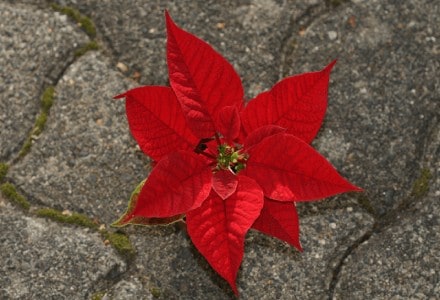
Poinsettia Facts
- This beautiful, and widely renowned, flora most frequently goes by the simple common name of the Poinsettia. It has other general titles, though. These include such diverse terms as Christmas star, lobster plant, painted leaf, and Mexican painted leaf.
- Among scientific professionals, however, it’s better known by its technical title. But that’s a somewhat difficult term for the layperson to pronounce. That’s because this remarkable product of evolution holds the formal moniker of Euphorbia pulcherrima.
- It received that official name due to the efforts of the respected German botanist, Johann Friedrich Klotzsch. He accomplished the first formal acknowledgement of it as a separate and distinct species. Tht scientifically noteworthy event took place in 1834.
- Regardless of which term once chooses, it remains well known species. The beautiful flora qualifies as a culturally and commercially important plant in many parts of the world. That’s due to the fact that it remains widely used in Christmas decorations.
- Due to its enormous popularity in cultivation, the overall population of the Poinsettia remains sufficient. In the wild, however, its population numbers appear scattered and perhaps dwindling. For now, though, it does not appear on the IUCN Red List.
- That wild population faces several threats to its continued existence. Most of those stem from the actions of man. They include such factors as habitat loss due to deforestation. The naturally occuring plants also now face the perils of climate change.
Related Articles
Wax Currant Stewartia Sego Lily
Poinsettia Physical Description
Perhaps most notably, the remarkable Poinsettia represents one of those uncommon plants that evolved a comparatively unique capacity. That’s because this stunning and incredible plant occurs naturally as either a shrub or small tree, depending on local conditions.
The impressive and remarkable tree form also has an impressive ability. In fact, it has the capacity to grow to heights measuring as much as an impressive 16 ft (4 m). Though that doesn’t compare to regular trees, it’s nonetheless incredible for this particular Angiosperm.
The lovely Poinsettia also bears foliage equally deserving of appreciation. This marvel of Nature produces dark green leaves that average between 3-6 in (7-16 cm) in length. The species also produces bracts that most commonly display the familiar bright red shade.
However, this intriguing plant sometimes develops as either orange, cream, pale green, pink, white or marbled, in color. When left to their own devices, these natural varieties typically grow into a wider form more closely resembling weeds than its more familiar shape.
- Kingdom: Plantae
- Phylum: Tracheophytes
- Class: Angiosperms
- Order: Eudicots
- Family: Euphorbiaceae
- Genus: Euphorbia
- Species: E. pulcherrima
Poinsettia Distribution, Habitat, and Toxicity
Currently, the breathtaking Poinsettia grows in many parts of the world. This widespread dispersal occurs only due to its popularity in cultivation. Since the species originally evolved in Mexico and Central America, it still only appears in small parts of North America.
The species also evolved within a very specific habitat range and type in the wild. Incredibly, it also possesses quite precise requirements for its habitat. That holds true because the vast majority of those still growing wild in the original range appear in one specific area.
This habitat consists specifically of gentle slopes, facing the Pacific Ocean. Even more specifically, these only develop at roughly mid-range altitudes. An exception to this tendency does exist, though. That’s because one small grouping does appear further inland.
Nature often protects its greatest treasures in powerful ways, however. The beautiful Poinsettia is no exception to this. A common misconception concerning the relative toxicity of the plant still remains, though. It’s believed to be extremely dangerous to man.
The plant does rank as toxic, but only slightly, however. Ingestion of any part of the flora by humans rarely results in more than mild symptoms such as regurgitation. Prolonged contact with the leaves also results in only mild skin irritation in sensitive individuals.
Species Sharing Its Range
Old Woman Cactus Tiger Rattlesnake Harpy Eagle
Check out our other articles on Incredible Sharks of the World, Wallace’s Flying Frog, Blyde River Canyon, White Egret Orchid, Blue Footed Booby, Eastern Diamondback Rattlesnake

